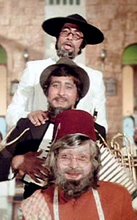Saturday, August 06, 2005
Songs of Hind
wherein the narrator reviews some of the popular nationalist and patriotic songs of the sovereign socialist secular democratic republic of Hind.
1. Jana gana mana
status: National Anthem
writer: Rabindranath Tagore
The song begins and ends with praise for Hind's glorious Ruler. In the middle is a list of rivers mountains and regions of Hind, which also praise the Ruler.
Cons
1. This song was originally written in honour of and in welcome of our colonizers' king's visit to Hind. This should have automatically disqualified it from being the theme song for a free Hind, but the writer had friends in high places.
1. The song does not celebrate, and is not in praise of, Hind or its people. Instead, it is an ode to Hind's rulers, and the praise is reserved for the overlords, not the country or its citizens.
2. A free people and a free nation, why should we sing the praises of "the ruler of...all people...the dispenser of destiny"???!!!! We dispense our own destiny now, but our national anthem misses the point altogether.
3. The writer argued later that it should be seen as a prayer to God, and that the people of Hind being religious wound understand this. In which case, prayer is a private matter of the individual, and it is not for the state to impose a particular prayer or God upon its citizens. A song of a religious nature is not appropriate for a secular nation, it is not acceptable as a national anthem.
4. The only alternative interpretation can be that the ruler being praised in the song was King George, Emperor of Hind (certainly it was written as a song of welcome for him). Should free citizens be celebrating their free nation by singing the praises of an old imperial ruler? No.
5. Other than praising our rulers, the song's only other theme is a menu listing various geographic regions and features of Hind. This is also problematic, because any making of lists also serves to indicate and highlight the exclusion of those not on it. And that is what happens - some states get mentioned, others do not. This particular list is also inaccurate, listing regions not part of Hind. Any list would have difficulties in being comprehensive and accurate, and that is understandable, but what is not is why an anthem should try and include such a list anyway, with all the consequent difficulties attached to it.
Pros
1. It is short;
2. And the official reason it was chosen apparently: Its tune is easy for foreign orchestras and bands to learn and play!
__________________________________________________________
2. Vande Mataram
Status: National Song
Writer: Bankim Chatterjee
This song praises Hind, comparing it with a mother or goddess.
Pros
1. The song is in praise of Hind.
post script: Well actually it is in praise of Bengal, only half of which is now in Hind, where it is one of 28 states. But let us be generous, and not notice that.
2. The song has historical relevance and significance, being a rallying
cry of the independence movement.
post script: and we all know what a disaster that was.
3. The song has (in the narrator's opinion) considerable literary merit. The descriptions in it are lush and evocative, the language is powerful and passionate.
Cons
1. The song is famously found in a nationalist book (Ananda Math) by the writer. But the writer's and the book's nationalism was not for Hind, but for a Hindu nation. The struggle the writer envisages is not one of Hindis against the firangi colonizers, but one of brother Hindus against brother Muslims, and this is the song to which his heroes march.
The song is not a celebration of the Hind we love. The Hind we love is inclusive and tolerant, this song was written as a rallying cry for division and hate. The country the writer has imagined is not Hind, but a perversion of it, and this should not be Hind's song.
post script:see below though. maybe the hindus and muslims first unite and then turn upon the muslims.
2. The content of the song is also problematic. While again noting the beautiful use of language, one must also point out the depiction of Hind, not just as a mother, but as the Goddess Durga.
If a person wishes to deify their country, it is their personal choice and they are free to do. However, there is no place for such religious imagery in the anthem of a secular nation. The divine is sensitive stuff, and many of Hind's citizens may love their country, but not consider it appropriate to refer to it as a Goddess. Others may think it is perfectly appropriate. In either case, it is not a matter for the state to be involved in. Gods and Goddesses should stay out of the business of the state, and that means for a start they should stay out of the national anthem. If you wish to build a huge temple for mother Hind and worship her there, by all means do so, but you have no right to impose your belief on every other citizen of Hind.
Random
1. The song refers to 70 million voices. It would be interesting to see the population figures from late 19th century and see precisely where the number comes from, and whom it refers to. Perhaps it may force a revision of one of the above points.
post script: As far as I can tell, the 70 million is the population of Bengal province at the time. But surely that included a significant muslim population. In which case are Hindu-Muslims all raising a sword (and their voice) for Durga before some of them turn on themselves and the others on their neighbours? Anthony, englighten please.
2. What to make of the use of God in the anthems and currencies of many Videshis? That they lack good sense.
